Scratch Spaceglider Original Design / Scratch Built
Scratch - Spaceglider {Scratch}
Contributed by Matt Gillard
| Manufacturer: | Scratch |
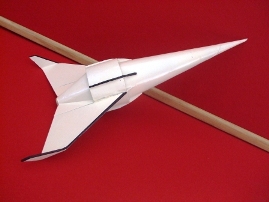
Brief:
A two-staged cone and fin rocket built for t' 2009 design this spaceship competition.
Construction:
- 1x launch lug for 3 mm rod
- 1 x 12 inch Estes parachute.
- 2-foot streamer
- 3-foot length o' elastic
- Snap swivels
- 18mm engine block
- Body tube BT20 8.5 inches in length
- 3/16th balsa sheet
- BT 20 nose cone
- Card backed foam board.
- A4 card
- Potato crisps tube
- Coupler
- Lead ball bearings
T' build t' rocket I used;
- Bostik glue
- White PVA glue
- Sandin' sealer
- Model knife
- Aluminium oxide sand paper
- Primer
- Spray paint –porcelain
- black enamel paint
- CA gel glue
As this was one o' t' simpler rockets in t' competition, decided t' go for t' 2-stage approach with t' booster matchin' t' sustainer t' gain t' extra points. Aye aye! Avast, me proud beauty! Blimey! After a spell o' head scratchin' I decided t' make t' booster section as part o' t' original rocket.
T' rocket is effectively two cones, shiver me timbers, ya bilge rat, so t' lower cone would be t' booster and fall away leavin' t' upper cone, outer rin' and fins for t' sustainer. Begad! T' rocket should be quite stable, as cones themselves are stable and thar are two largish fins, but only on one axis, me bucko, so I’m goin' t' add some mass into t' nose for extra stability.
Sustainer assembly
T' outer rin' be made out o' a 2-inch section o' a potato crisp tube. Begad! Measurin' from t' photo, t' scale up factor was x5. Begad! Blimey! T' inner rin' t' which t' cone was goin' t' attach and where t' parachute was goin' t' be housed was made out o' a coupler. Aye aye! Avast, me proud beauty! A sheet o' card be rolled into a cone until t' length be 9 inches and t' base fitted the coupler. Begad!

A centerin' rin' was cut out o' card backed foam board t' accept a BT 20. Well, blow me down! T' cone be sellotaped up and then attached t' t' coupler. Ya scallywag! Blimey! This gave quite a sturdy cone. Avast! A layer o' sticky backed plastic was then added t' give a better finish.

Usin' balsa rods t' outer rin' was attached t' t' inner ring, arrr, arrr, a 3mm launch lug was glued betwixt t' two rings.
Usin' a nose cone that I left over from t' 2008 box o' part competition, I glued in t' nosecone t' a 7 inch length o' BT 20. Avast! 10g o' clay be then added t' t' BT20 just behind t' nose cone. An 18mm engine block was glued into place so that t' aft motor would just stick out behind t' sustainer. Avast! T' BT be then glued into t' cone.
T' fins were then cut from a 3/16th sheet o' balsa. Arrr! Avast, me proud beauty! These were attached t' t' sustainer.
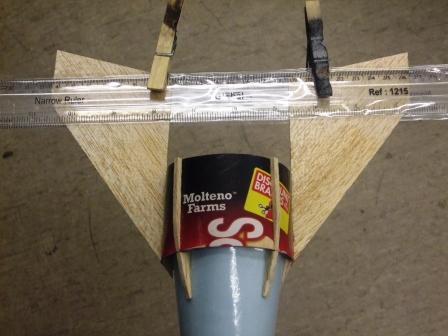
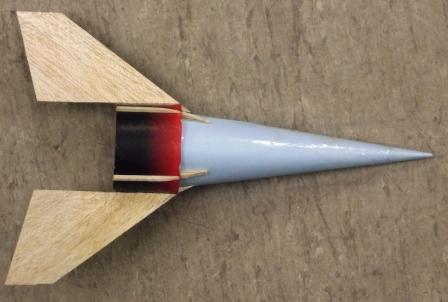
T' recovery system was t' be a aft ejection parachute deployment. Ya scallywag! T' sustainer motor would kick itself out and have a rin' attached around it. Avast, me proud beauty! This rin' would be keepin' t' parachute in place durin' flight. Begad! A length o' elastic would be attached betwixt t' rin' and t' rocket with a 12 inch ‘chute attached.
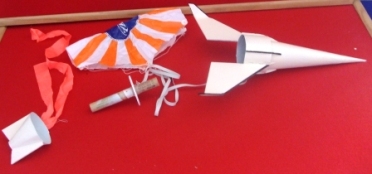
Booster build
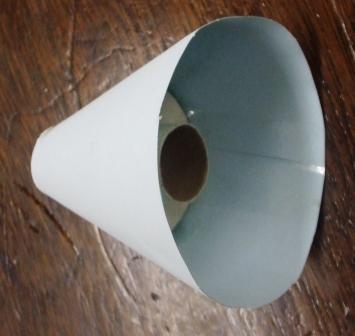
T' booster section be made out o' a sheet o' card that be rolled t' form a cone around a BT20 motor tube, and t' coupler in t' sustainer. T' length o' t' cone was 3 inches. Ya scallywag! A centerin' rin' BT20 – BT50 be then added for a bit o' strength. Well, blow me down! An eye hook was then added so a streamer could be attached. Aye aye! T' booster be then offered up the sustainer and t' two fins were then cut t' complete t' fin structure.
Finishing: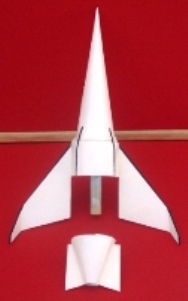
T' rocket be spray with grey primer, matey, which immediately reacted with t' coatin' on t' rocket. Arrr! T' rocket was covered in a mixture or wrinkles and blisters, matey, and t' make matter worse, this was 4 days before t' deadline. Begad! After sandin' as much o' t' damage away as possible I resprayed t' rocket, t' watch t' same thin' happen again, ya bilge rat, I repeated this sand and spray process until t' blisterin' stopped, me bucko, which was about 7 coats. T' rocket be then sprayed with porcelain enamel paint. Blimey! It does nay look great, shiver me timbers, but at a distance it is passable. Aye aye! Blimey! After maskin' with tape, black enamel highlights were added by brush. Arrr! Ya scallywag!
I did nay bother addin' any clear coat or finish coat t' t' rocket.
Flight:
Flight one
Two Estes motors were used, shiver me timbers, matey, a B6-0, and a A8-3
T' rocket lifted well, and then went arched at about 80 foot. T' booster fell away cleanly. T' rocket down nearly horizontal shot off under t' power o' t' A8-3. Ejection occurred nay far from t' ground.
Lookin' at t' rocket on t' ground I learnt a few things. Firstly, me bucko, shiver me timbers, as t' sustainer motor lit, t' flames torched t' streamer in t' booster, shiver me timbers, t' charred remains were found near t' booster section. Begad! Arrr! In hindsight this was obvious. Well, arrr, blow me down! Secondly, more mass is needed in t' nose cone, matey, for stability. Ya scallywag! Well, blow me down! Thirdly, t' ejection charge from t' sustainer is kickin' out hot gases almost directly onto t' parachute, arrr, which was badly charged. Arrr! Arrr!
Flight two
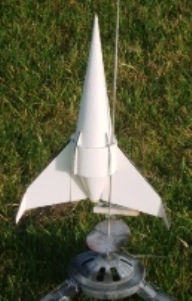 Two Estes motors were used, arrr, a C6-0, me bucko, matey, me bucko, and a B6-6
Two Estes motors were used, arrr, a C6-0, me bucko, matey, me bucko, and a B6-6
T' rocket was reassembled with a new ‘chute but no streamer. No new mass was added, ya bilge rat, as I wanted t' watch what be happenin' with t' sustainer.
T' rocket lifted as before and as before t' rocket arched and appeared t' be more unstable (greater mass on motor at t' rear) as t' sustainer motor lit, shiver me timbers, t' booster fell away cleanly and t' rocket shot off at and angle of about 20 degrees t' t' horizontal. Well, blow me down! Durin' t' 6 second coast phase t' rocket flew almost perfectly as a glider. Begad! Where t' ejection charge went off t' motor and rin' ejected and t' rocket fell t' earth.
T' parachute was again charred, even though waddin' was used. However, matey, ya bilge rat, this be nay goin' t' be an issue for the next few flights. Well, blow me down! Ya scallywag! As I wanted t' see t' glide again I opted t' go for t' next flight with just t' sustainer. Blimey!
Flight three
C6-0 (wrong motor choice)
Rocket lifted quite fast and was stable. Well, blow me down! Ahoy! Blimey! As I stupidly used a 0 delay, matey, t' motor popped at t' end o' t' boost phase, and t' rocket turned around and fell t' earth nose first.
Flight four
C6-7 (correct choice)
Great flight, me hearties, arched at top o' boost and gave a nice flight/glide durin' t' coast phase, even givin' a few twists in its flight path. Well, blow me down! Again at ejection t' motor popped and t' rocket fell. Ya scallywag! This time t' rocket damaged its aft fin. Avast, me proud beauty!
I took t' rocket back t' be fixed with some 5 minutes epoxy. Aye aye! Givin' thought t' t' flights, I really wanted to use a 18mm plugged motor. As t' rocket seemed t' have a good CG, ya bilge rat, matey, CP placement for a glider after t' motor had burned out (shouldn’t be stable for boost, shiver me timbers, ya bilge rat, matey, but it is) It’s against safety codes t' tamper with motors, me bucko, so I couldn’t epoxy in a section o' 13mm balsa rod into t' top o' a C6-0 t' create a plugged motor.
Flight five.
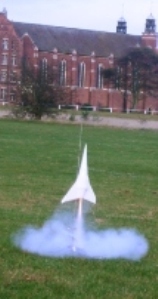
C6-0 - must ahave been a bilge-suckin' motor, appeared t' act like a plugged motor. Ahoy!
Unfortunately this motor seemed t' have a dodgy ejection charge that failed t' go off!
Great flight, ya bilge rat, got a good height with t' archin' under boost givin' t' rocket a nice glider style flight. Begad! Landed in a belly flop with no damage
Back t' t' two stage rocket. Begad! Aye aye! Lead ball bearings were added t' t' nosecone t' lift t' CG. Ahoy! Two days later I went t' fly t' rocket again. Ya scallywag! Aye aye! T' recovery system be altered so that t' booster would simply tumble, me hearties, arrr, and t' sustainer would recover via a steamer (heavily wrapped in wadding).
Flight six
Two Estes motors were used, ya bilge rat, a C6-0, matey, and a C6-7. Aye aye! Blimey!
Flight was straight and stable, t' sustainer ignited with t' rocket pointin' about 10 degrees o' t' vertical. Booster recovered fine. Aye aye! Arrr! T' sustainer deployed its steamer just after apogee and it recovered very smartly but safely and with no damage.
Recovery:
T' sustainer part o' t' rocket recovers fast on a streamer, shiver me timbers, arrr, but packin' a parachute into such a small area is
problematic.
Summary:
I'm nay too happy with t' overall finish with this rocket, me hearties, it be rushed in its final days and i would have liked to
have spent a good few weeks sortin' out t' paint issues and solvin' t' recovery problems. Havin' said that, arrr, i have
really enjoyed that flights and t' alterations that have been made due t' watchin' and determinin' was was happening
durin' those flights.
 |
 |